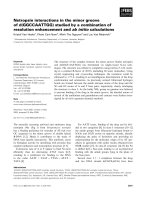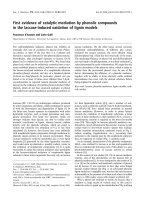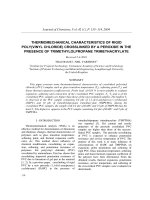Sustainable forest management by local people in the buffer zone of ba vi national park
Bạn đang xem bản rút gọn của tài liệu. Xem và tải ngay bản đầy đủ của tài liệu tại đây (621.78 KB, 52 trang )
VIETNAM NATIONAL UNIVERSITY OF FORESTRY
FOREST RESOURCES & ENVIRONMENTAL MANAGEMENT FACULTY
STUDENT’S THESIS
SUSTAINABLE FOREST MANAGEMENT BY LOCAL PEOPLE
IN THE BUFFER ZONE OF BA VI NATIONAL PARK
Major: Natural Resources Management (AC)
Code: D850101
Faculty: Forest Resources and Environmental Management
Student: Luong Ngoc Minh
Class: K59B-Natural resources management
Student ID: 1453092229
Course: 2014-2018
Advanced Education Program
Supervisor: Associate Professor Dr Tran Thi Thu Ha
Research location: Ba Vi National Park – Ha Noi
Hanoi, October 2018
CONTENTS
I. Introduction ........................................................................................................................ 1
II. Goals, Objectives and Research Subjects ......................................................................... 4
1. Goal ................................................................................................................................ 4
2. Objectives ....................................................................................................................... 4
3. Research subjects ........................................................................................................... 4
III. Methods ........................................................................................................................... 5
3.1 Study area ..................................................................................................................... 5
3.2. Data collection ............................................................................................................ 7
3.2.1. Document Inheritance .......................................................................................... 7
3.2.2. Interviewing local people in Yen Bai and Ba Vi commune ................................. 7
3.2.3. Interviewing officials of Ba Vi national park ....................................................... 8
3.2.4. Interviewing officials, forest rangers of Yen Bai and Ba Vi commune ............... 8
3.2.5. Using PRA tools ....................................................................................................... 8
3.3 Data analysis ................................................................................................................ 9
3.3.1 Data accessing ....................................................................................................... 9
3.3.2 SWOT analysis .................................................................................................... 10
IV. Results ........................................................................................................................... 10
4.1 The description of the respondent .............................................................................. 10
4.2 Impacts of local people on forest resources ............................................................... 11
4.2.1 Using forest land for agriculture .......................................................................... 15
4.2.2 Forest products exploitation ................................................................................ 16
4.2.3 Causes of the impacts .......................................................................................... 18
4.3 Sustainable forest management by local people ........................................................ 19
4.3.1 The awareness of local community about sustainable forest management ......... 19
4.3.1.1 The awareness of local community about sustainable forest management based
on gender ...................................................................................................................... 20
4.3.1.2 The awareness of local community about sustainable forest management based
on occupation................................................................................................................ 21
4.3.2 The situation of sustainable forest management in Ba Vi National Park ............ 22
4.3.2.1 Forms of managing forest sustainability in research areas ............................... 23
4.3.3 Factors affecting to the participation of local people in sustainable forest
management. ................................................................................................................. 24
4.3.4 Reasons for not participating in forest managing ................................................... 25
4.3.5 Reasons for participating in forest managing.......................................................... 28
4.3.6 Causes of factors affecting to the participation of local people in sustainable forest
management ..................................................................................................................... 29
4.3.6.1 Limited awareness ............................................................................................ 29
4.3.6.2 Lack of efficient polices and environmental projects ....................................... 30
4.3.7 Assessing the status of sustainable forest management by strengths, weakness,
opportunities and threats............................................................................................... 30
4.3.8 Raising awareness of people ............................................................................... 32
V. Conclusions and recommendations................................................................................. 33
5.1. Conclusions ............................................................................................................... 33
5.2 Recommendations ...................................................................................................... 34
References ............................................................................................................................ 36
LIST OF FIGURES
Figure 3.1 Map of Ba Vi National Park and its location ......................................................... 7
Figure 4.1: Ratio of land use for agriculture at Ba Vi National Park .................................... 16
LIST OF TABLES
Table 4.1.Descriptions of respondents ................................................................................. 11
Table 4.2.Knowledge level about sustainable forest management according to gender ..... 12
Table 4.3.Knowledge level about sustainable forest management according to age group 13
Table 4.4.Knowledge level about sustainable forest management according to occupation14
Table 4.5 Participation levels in exploiting forest products according to age group ........... 17
Table 4.6 Forest exploitation products ................................................................................ 18
Table 4.7 Assessing important level of sustainable forest management according to gender20
Table 4.8 Assessing important level of sustainable forest management according to
occupation ............................................................................................................................ 21
Table 4.9 Types of forest in Yen Bai and Ba Vi commune ................................................. 22
Table 4.10 Forest areas classification according to objects management in Yen Bai and Ba
Vi commune in 2017............................................................................................................ 23
Table 4.11 Source of information for local people about sustainable forest management .. 25
Table 4.12 Reasons why local people don’t take part in sustainable forest management
(law enforcement agency's opinions) ................................................................................... 26
Table 4.13 Reasons why local people don’t take part in sustainable forest management
(local people's opinions) ...................................................................................................... 27
Table 4.14 Reasons why local people take part in sustainable forest management (law
enforcement agency's opinions) ........................................................................................... 28
Table 4.15 Reasons why local people take part in sustainable forest management (local
people's opinions) ................................................................................................................ 29
Table 4.16 SWOT analysis .................................................................................................. 30
ACKNOWLEDGMENT
I would like to send my sincere thanks and deep gratitude to the teachers of Viet
Nam National University of Forestry, especially Associate Professor Dr Tran Thi Thu Ha
for guiding me complete this graduation thesis. With the knowledge acquired during the
learning process is not only the foundation for the research process but also the precious
jewelry to enter the life firmly and confidently.
I sincerely thank the Board of Directors of Ba Vi National Park, People's Committee
of Yen Bai and Ba Vi Commune has allowed and created favorable conditions for me to
finish the graduation thesis here.
In the end, I wish you all the best in your career, your health and your success
Student
Luong Ngoc Minh
ABSTRACTS
An overview of sustainable forest management, the relationship between local people
and law enforcement in protecting and enhancing the value of forest resources in Ba Vi
National Park. Learning about livelihood of local communities and how they affect to the
forest’s reserve, listing and analyzing the management activities and their impact on local
communities. Moreover, improving the soft skills of researchers like: communication,
observation, document inheritance, creating questionnaire table, interviewing local people
& law enforcers and giving recommendations to raise awareness of local people in Ba Vi
National Park.
I. INTRODUCTION
Forests are one of the most valuable resources that bring a number of benefits to
people, especially those who live inside it. The forest ecosystem is highly complex, and
influenced by numerous external factors. Similarly, different forest types in different
regions of the world require different sustainable management strategies. However,
uncontrolled activities of local community have been considered as the main reason of
forest degradation and forest lost. Supports for the local people to live and work are so
limited and tends to make changes to local people’s livelihood due to the changes in
accommodation, cultivation habit and to the change in forest products can normally
harvest.
With the development of science, technology and socio-economic development,
forest management has shifted from managing timber business to multi-faceted business
management of forest resources, sustainable forest management is based on strict,
comprehensive criteria and criteria in economic, social and environmental fields.
Sustainable forest management requires forest managers to make detailed forest
management plans, the main objective of sustainable forest management is to "manage the
sustainable forest stands to achieve the set management objectives, ensure continuous
production of forest products and services., but not significantly reduce the future value
and productivity of the forest and does not cause undesirable effects on the natural and
social environment.
To find helpful solution to deal with those issues, sustainable forest management
always the best choice because it requires the participation of local communities and law
enforcement offices. Sustainable forest management means the environmentally
appropriate, socially beneficial, and economically viable management of forests for present
1
and future generations [1]. Forest ecosystems are complex and influenced by many
external factors so, different forest types in different regions of the world require different
sustainability management strategies.
Most of the previous researches show the same results that the poor in many
communes and villages living in remote areas and near the forest are running out of forest
resources and the nature is seriously harmed. More than 1.6 billion people around the
world depend on forest resources for their livelihoods – not just for food but also for fuel ,
for livestock grazing areas and for medicine (Arthur E. and Pol D.G.,2000) [2] . 1.2 billion
people use trees on farms to generate food and cash moreover, many countries in the
developing world draw on fuel wood to meet as much as 90% of energy requirements
(FAO, 2015) [3] , so local communities play important part in sustainable forest
management in the world.
Viet Nam has been involved in sustainable forest management since 1998, some case
studies such as Dao Cong Khanh (2014) [4] and Nguyen Ngoc Lung, Ngo Dinh Tho [5]
show that the forest area have FM certification and the product chain certificated is not
much; However, with the support from the Government, Ministry of agriculture and rural
development and other line ministries, local authorities, the voluntary enthusiasm of the
forest owners, the process of sustainable forest management has been improved.
Significant progress has been made, especially in the areas where timber is grown and
harvested and exported.
It is believed that the higher populations living in buffer zone, the greater impact they
have on natural forest resources because they are adjacent in boundary and directly benefit
from forest. In spite of the numerous functions of forest management strategies, forest
ecosystems in general and forest resources particular are gradually degrading in quality
2
under threat as a result of the growing population and expanding consumption of forest
resources (FAO, 2007) [6]
Ba Vi National Park was established in 1991 under the Decision No. 17-CT of
January 16, 1991 of the Chairman of the Council of Ministers of Vietnam with a total area
of 108.15 km². This park is distributed in 5 districts including Ba Vi , Thach That , Quoc
Oai (belong to Ha Noi City) and Ky Son , Luong Son (belong to Hoa Binh Province). It’s
about 60 km far from Hanoi center following the national road No. 21A and 87A. It has
high biodiversity value with large number of plant and wild animal species, provide forest
services such as ecotourism and recreation, sites for scientific and educational purposes:
1,200 plant species, of which 21 species were listed in Viet Nam’s Red Data book (2007)
[7]. The buffer zone of this national park includes 16 communes, in which 7 of them are
mountainous communes: Minh Quang , Khanh Thuong, Tan Linh , Ba Trai, Ba Vi , Yen
Bai and Van Hoa communes (belong to Ba Vi district), with the total area of 14,144 ha and
the population of 46,547 people. However, natural forest and resources within national
park area is facing many threats because living standard of ethnic people here is still low,
they mostly rely on forest resources such as fuel wood, NTFPs, hunting wild animals for
food, etc. Moreover, the awareness of forest resources management is quite low and the
participation of local people in management programs have met many difficulties because
of scattered settlements.
Therefore, the protection and maintenance of the rehabilitation and development of
Ba Vi National Park, but still ensuring the harmony with local economic and development
activities, is being considered as a challenge with conservation activities here. It is
therefore necessary to have assessments to identify socio-economic development issues
that have a positive impact on the natural resources as well as to address gaps in
conservation management, recognizing the importance of ecosystems, the urgency of
3
strengthening more effective activities for conservation activities in Ba Vi National Park, I
chose the topic “Sustainable forest management by local people in Ba Vi National Park”.
The result of this thesis is to bring out the economic development issues of local
communities for conservation activities in Ba Vi National Park, to find out the
shortcomings in management, conservation and development. Based on that assessment to
put forward a PR plan to raise awareness of local people in Ba Vi National Park.
II. Goals, Objectives and Research Subjects
1. Goal
Assessing the relationship between local livelihoods and forest protection activities
to build a PR program with the purpose of promoting the forest protection sustainably for
people in Ba Vi National Park
2. Objectives
- To assess the current situation of forest management in Ba Vi national park.
- To evaluate effects of local people in buffer zone to forest resources in Ba Vi
national park
- To determine factors that influence on efficiency and effectiveness of sustainable
forest management by local people in Ba Vi National Park
- Relate the livelihoods of local people to their attendance in sustainable forest
management
- Suggesting solutions to improve the efficiency and effectiveness of community
forest management in Ba Vi National Park.
4
3. Research subjects
Livelihood attitudes and activities of communities in the core zone and nature
preservation of Ba Vi National Park (with the combination of forest protection for law
enforcement agencies)
III. METHODS
3.1 Study area
The study areas must be representative for the whole area and respond to these
criteria:
- Inside the buffer zone of Ba Vi National Park
- More than 2 ethnic groups living inside those areas
- Selected villages represent for that commune (number of household and ethnic
group , economic customs) and selected household represent for that village ( some
wealthy , some poop and some closed-poor families)
Based on published documents and law enforcement’s agencies interviewing (Local
officials and forest rangers), the ethnic group is an important factor that affects production
system like economy , livelihood condition and the way people affect forest resources.
Therefore, 2 communes: Ba Vi and Yen Bai commune were selected for a detail study in
Ba Vi National Park
According to Yen Bai Vice chairman of the commune committee (2015) [8], this
area is a mountainous commune, low terrain from south west to north east, between the
hills and the lowland fields and terraces, this terrain is favorable for the development of
fruit trees, perennial trees while Ba Vi commune located in the North of Ba Vi national
park with low hill and mountains alternate with fields and small shallow streams
5
According to the data recorded from Ba Vi hydrometeorology station, the average
temperature in both area is 23.4 °C, the coldest month is January (16.5 °C) and the hottest
month is July (28.7 °C). The average precipitation is 2,587 mm. The difficulties of weather
are the dry west wind from May to July and white frost in winter.
In Yen Bai commune, the number of household are 1874 with 7486 people and
ethnic groups occupy 49% of local population while Kinh people occupy 51%. Total area
of land is about 3541.86 hectares. Agriculture cultivation, cattle breeding and service are
three main sources of income in this commune. However, agriculture production is still the
largest source of income here, so it leads to one truth that people depend much on forest
resources
In Ba Vi commune, Dao ethnic people occupy 97.3 % of total population while
Kinh people occupy only 2.7%. This commune has the highest number of Dao people
compared with other 6 communes in buffer zone of the national park. Average land is
estimated about 977 m2 per capita. Agriculture cultivation and cattle breeding are two
main sources of income in this commune. There are about 50-60% total household have
traditional medicine job. Other jobs are farming, breeding and bee-keeping so, their life
depends on forest resources.
6
Figure 3.1 Map of Ba Vi National Park and its location
(Source: Ba Vi National Park, 2017)
3.2. Data collection
3.2.1. Document Inheritance
Surveys were conducted in Ba Vi National Park at People’s committees offices of 2
communes and management offices of Ba Vi national park. This information is used for
selecting data in natural and socio-economic conditions of the study areas. The material’s
data will help me in analyzing the data about forest location, type and resources using since
local people depends on forest resources and their point in sustainable forest management.
Some important materials are collected such as buffer zone research reports, buffer
zone & National Park development meetings, local participation in forest protection
meetings, some buffer zone laws and policies, etc.
7
3.2.2. Interviewing local people in Yen Bai and Ba Vi commune
A random sample of 100 households in Ba Vi and Yen Bai commune are selected in
the survey. Questionnaires are prepared (Appendix 02) before the field trip , the main
questions will focus on living area, gender, age, source of income , education level ,
occupation, relationship between them and forest, their point and attitude in sustainable
forest management
3.2.3. Interviewing officials of Ba Vi national park
Based on questionnaires in Appendix 01, the study conducted an interview of 4
officials at the park, the main questions focus on the change of forest use in buffer zone by
communes in the past and recent years, corporation between Ba Vi National park and local
communities in buffer zone in supporting the participation of local people in protecting and
managing the forest in the past, now and in the future.
3.2.4. Interviewing officials, forest rangers of Yen Bai and Ba Vi commune
A questionnaire was used to interview 5 officials from each commune including:
Chairman, vice-chairman of the commune, and 3 forest rangers. These interviewing aims
to find out information about forest resources protection and management of law
enforcement agencies, policies and situation of sustainable forest management of local
people and the way powerful officials support for their protection and management here.
Moreover, these interviews will have the cross-checked on the information collected from
Ba Vi national park and local community.
3.2.5. Using PRA tools
Participatory Appraisal of Rural (PAR) is a growing combination approach and
method that enable rural people to share, enhance and analyze their knowledge of life and
8
condition to plan, act, monitor and evaluate their situation and finding solution. The role of
the outsider is that of a catalyst, a facilitator of processes within a community which is
prepared to alter their situation
In this study, PRA tools are used to interview commune members, households and
leaders.
Interviewing village managers is the first step when arriving to each village. The
purpose of this is to find some information about the socio-economic, population,
livelihood, main jobs, land and forest resources used. This provides information on the
ways local people effects on forest resources and the awareness of people about sustainable
forest management
Another purpose on this stop is to learn about some organization activities (woman
association, Communist Youth Union, Old People association…) in the community
because these organizations have impact on the participation of local people on forest
management
3.3 Data analysis
3.3.1 Data accessing
Data collected after interviewing is summarized and analyzed by Excel software
and the result is shown by tables and charts
Analysis steps:
- Data recording (voice recorder required )
- Read transcripts
- Highlight quotation marks and note important reasons
9
- Quoting the code by the marginal character
- Sort citations into encrypted groups (topics).
- Explain the patterns in quotation marks
- Describe these patterns
Information about research areas like policies and law will be summarized and
noted
By studying the available conditions of 2 buffer communes and Ba Vi national
park, the comments and ideas from local community and communes which are suitable for
local development will be given.
3.3.2 SWOT analysis
Use SWOT tools to address the strengths, weaknesses, opportunities and threats of
community-based forest management in Ba Vi National Park and then propose ways to
reduce vulnerabilities and threats. Use the table below to analyze:
Opportunity
Strengths
Weakness
Use strengths to take opportunity
Overcome weakness that stopping
us to opportunity
Use strengths to reduce threat
Threat
Overcome weakness that can be
threat
IV. RESULTS
4.1 The description of the respondent
114 respondents (65 random households) of participated in the interview including
local people and staffs. They were chosen randomly to answer the prepared questionnaire.
The details of the respondents are shown in the table below:
10
Table 4.1.Descriptions of respondents
Demographic
Gender
Education level
Age group
Occupation
Respondents
Number
Percentage
Male
49
42.9%
Female
65
57.1%
Primary school
3
2.64%
Secondary school
7
6.14%
High school
49
42.92%
University
55
48.3%
13-22
26
22.8%
23-40
39
34.2%
40-60
42
36.85%
>60
7
6.15%
Law enforcement
14
12.28%
Private
24
21.05%
Own business
31
27.2%
Housewife
20
17.55%
Student
13
11.4%
Retire or
12
10.52%
unemployment
(Source: Results collected by author’s field trip, 2018)
4.2 Impacts of local people on forest resources
Most people in the buffer zone of the national park depend their life on the forest
resources, they often don’t realize the important of forest protection, 2 tables below show
11
the differences in knowledge about using forest resources between 2 genders and age
group:
Table 4.2.Knowledge level about sustainable forest management according to gender
Gender
Male
Female
Knowledge level about sustainable forest management
Well
Medium
Weak
Unknown
Number
10
9
10
20
%
20.4%
18.4%
20.4%
40.8%
Number
6
28
22
9
%
9.23%
43.07%
33.85%
13.85%
(Source: Results collected by author’s field trip, 2018)
20.4% male participants have well knowledge about sustainable forest management
while female participants have 9.23%. Most of female participants have medium
knowledge about their role in managing the forest (43.07%) while the same level of male
participants is only 18.4%. The biggest surprise is the weak and unknown rates in two
genders (Weak: Male - 20.4 %, Female – 33.85%; Unknown: Male – 40.8%, Female 13.85%), that leads to conclusion that men in these areas are main labors of their families,
so they have to depend on collecting forest resources to
earn money and have no
experience about sustainable forest management while women have the support in
accessing the information about sustainable forest management from social organizations
like Woman’s union and Commune’s Youth Group.
12
Table 4.3.Knowledge level about sustainable forest management according to age
group
Age group
13-22
23-40
40-60
>60
Knowledge level about sustainable forest management
Well
Medium
Weak
Unknown
Number
2
5
11
8
%
7.69%
19.25%
42.32%
30.73%
Number
7
14
8
10
%
17.95%
35.89%
20.51%
25.65%
Number
6
16
9
11
%
14.28%
38.09%
21.43%
26.2%
Number
1
2
4
0
%
14.29%
28.57%
57.14%
0%
(Source: Results collected by author’s field trip, 2018)
The age group has the highest knowledge about sustainable forest management is
group 23-40 years old, most of people in this group are now seniors at the university or
working in many environmental projects, so they have chance to access with helpful
documents about managing and protecting forest, they are also the guider for raising the
awareness of people living around them. The second-highest group is group 40-60 years
old – they gain information from schools, television and propagandas from commune
office. The lowest knowledge about sustainable forest management is group 13-22 years
old, people in this period are still students and specific knowledge about managing forest is
very difficult for them to observe.
13
Table 4.4.Knowledge level about sustainable forest management according to
occupation
Occupation
Knowledge level about sustainable forest management
Well
Medium
Weak
Unknown
Number
10
4
0
0
%
71.4%
28.6%
0%
0%
Number
1
9
7
7
%
4.18%
37.5%
29.16%
29.16%
Number
1
7
10
13
%
3.22%
22.6%
32.25%
41.93%
Number
1
6
8
5
%
5.0%
30.0%
40.0%
25.0%
Number
2
7
2
2
%
15.38%
53.86%
15.38%
15.38%
Retire or
Number
1
4
5
2
unemployment
%
8.3%
33.4%
41.6%
16.7%
Law enforcement
Private
Own business
Housewife
Student
According to the result, the highest knowledge about sustainable forest
management is the group of people working for law enforcement organizations: 10 people
(71.4%) have well knowledge and the others have medium knowledge, none of them is
weak or unknown about this specification. The second is student with 15.38% of them (2
people) well knowledge, 53.86% (6 people) medium knowledge and only 2 students have
weak knowledge about this specification. These groups have chances to approach useful
documents and meetings about sustainable forest management due to the specification of
their jobs. The group has lowest sustainable forest management knowledge is own business
14
with only 1 people (3.22%) have well knowledge,10 people (32.25%) have weak
knowledge and 13 of them don’t know anything about sustainable forest management
while they are living in the buffer zone of Ba Vi National Park. These group have weak
knowledge about sustainable forest management because their business have to depend on
the resources in the buffer zone of the forest , so they don’t care much about consequences
of overexploitation as well as protecting the forest resources.
According to the annual report of Forest ranger station of Ba Vi National Park
(2017) [9], local communities in recent years still significantly effects on forest resources.
In 2017, there were 6 illegal activities:
2 cases of illegal logging
1 case of break laws of timber exploitation
2 cases of break general regulation of forest protection
1 case of forest fire
4.2.1 Using forest land for agriculture
After analyzing the questionnaire, 30/65 households are using forest land for
agriculture activities, the others don’t use their land for these purposes. Total forest land
used area is 32,460 m2. Land is mainly used to grow cassava, corn and tobacco, medical
plants and fruit trees.
15
Land use purpose for agriculture activities at
Ba Vi National Park
2122,4
3405,8
2921,4
Tobacco
Fruit
Cassava
4544,4
Corn
19.476
Other agriculture products
Figure 4.1: Ratio of land use for agriculture at Ba Vi National Park
Local people investigated during the research confessed that they are using more
fertilizer year by year, in 2010 the quantity of fertilizing is about 50 kg/1000 m2, but now
the quantity increases to 90-150kg and this action made the soul arid and exhausted, too
much chemical entering soil without any solution to improve the soil resulting in nutrient
leaks and soil exhaustion.
4.2.2 Forest products exploitation
Exploiting forest product in the buffer zone of Ba Vi national park is illegal, but a
large number of local people here have to depend their life on selling forest product, 50/65
interviewed households said that that usually go to the forest and get forest products such
as medical plants, honeybees, timber, vegetation, etc.
16
Table 4.5 Participation levels in exploiting forest products according to age group
Age group
Participation levels in exploiting forest products
High
3 times/week
participation
13-22
23-40
40-60
>60
Less than 3
No
times/week
participation
Number
0
3
7
16
%
0%
11.64%
26.72%
61.54%
Number
12
15
7
5
%
30.77%
38.46%
17.94%
12.83%
Number
15
14
6
7
%
35.71%
33.3%
14.29%
16.7%
Number
2
1
1
3
%
28.58%
14.28%
14.28%
42.86%
The highest age group that has the highest participation in exploiting forest
products is group 40-60 years old with 15 people (35.71%) getting forest products more
than 3 times a week, 14 of them (33.3%) join those illegal actions 3 times a week, 6 people
(14.29%) less than 3 times/week and 7 of them never get into the forest to exploit forest
products. The reason why exploiting forest products becomes popular in this group is this
group has a lot of experience in finding and collecting forest products, furthermore, people
in this group have family to take care of , so they will find many way (even illegal) to
increase their family’s life standard.
In Ba Vi commune, Dao ethnic people occupy more than 90% of the population
and medical plants are the most exploited products here, Dao people have traditional ways
to distinguish useful medical plants and normal plants, they also know how to process
17
those plants into traditional medicines, the revenue from selling medical plants is estimated
about 30-40 VND millions/year – average amount: >20 kg/year/household. Beside medical
plants, timber, honeybee and forest vegetation are special local products that are always
welcomed in family as well as markets.
Table 4.6 Forest exploitation products
No
Products
Number of
Ratio in total
household
65 households
Amount
Unit
Amount/month
Mean
quantity
(%)
1
Medical
32
49.23
Kg
374
5.75
plants
2
Firewood
25
38.46
Kg
600
9.23
3
Vegetation
36
55.38
Kg
391
6.01
4
Honeybee
4
6.15
Liter
4.2
0.006
Results from the table clearly show the participation of local commune in buffer
zone of Ba Vi National Park are affecting on forest resources very seriously, their action
affect not only forest quality but also wildlife’s habitat, furthermore, some dangerous forest
exploitation like cutting tree for timber or getting honeybee can cause forest fire or
diseases to exploiters due to the poison of jungle bee.
4.2.3 Causes of the impacts
Economic is the main cause that leads to the impacts of local people on forest
resources.
Economy causes: in the modern world, there are 3 main basic demands for our life:
food, money and fuel wood, so to meet the demands, people here have to depend on forest.
18
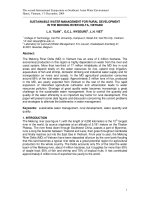
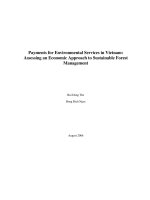
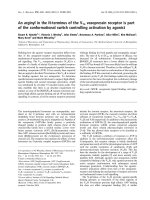
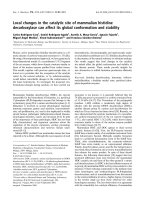

![Báo cáo khoa học: Epoxidation of benzo[a]pyrene-7,8-dihydrodiol by human CYP1A1 in reconstituted membranes Effects of charge and nonbilayer phase propensity of the membrane pot](https://media.store123doc.com/images/document/14/rc/ld/medium_ldo1394248806.jpg)
